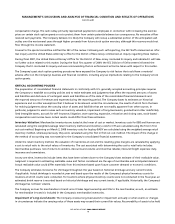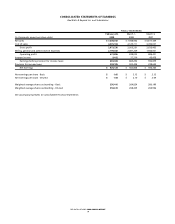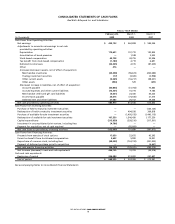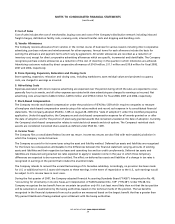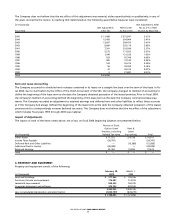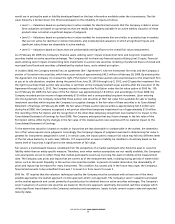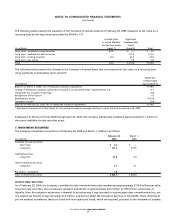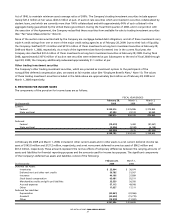Bed, Bath and Beyond 2008 Annual Report Download - page 22
Download and view the complete annual report
Please find page 22 of the 2008 Bed, Bath and Beyond annual report below. You can navigate through the pages in the report by either clicking on the pages listed below, or by using the keyword search tool below to find specific information within the annual report.
BED BATH & BEYOND 2008 ANNUAL REPORT
20
P. Cost of Sales
Cost of sales includes the cost of merchandise, buying costs and costs of the Company’s distribution network including inbound
freight charges, distribution facility costs, receiving costs, internal transfer costs and shipping and handling costs.
Q. Vendor Allowances
The Company receives allowances from vendors in the normal course of business for various reasons including direct cooperative
advertising, purchase volume and reimbursement for other expenses. Annual terms for each allowance include the basis for
earning the allowance and payment terms which vary by agreement. All vendor allowances are recorded as a reduction of
inventory cost, except for direct cooperative advertising allowances which are specific, incremental and identifiable. The Company
recognizes purchase volume allowances as a reduction of the cost of inventory in the quarter in which milestones are achieved.
Advertising costs were reduced by direct cooperative allowances of $14.9 million, $11.1 million and $10.6 million for fiscal 2008,
2007 and 2006, respectively.
R. Store Opening, Expansion, Relocation and Closing Costs
Store opening, expansion, relocation and closing costs, including markdowns, asset residual values and projected occupancy
costs, are charged to earnings as incurred.
S. Advertising Costs
Expenses associated with direct response advertising are expensed over the period during which the sales are expected to occur,
generally four to six weeks, and all other expenses associated with store advertising are charged to earnings as incurred. Net
advertising costs amounted to $266.4 million, $239.6 million and $198.4 million for fiscal 2008, 2007 and 2006, respectively.
T. Stock-Based Compensation
The Company records stock-based compensation under the provisions of SFAS No.123R which requires companies to measure
all employee stock-based compensation awards using a fair value method and record such expense in its consolidated financial
statements. The Company adopted SFAS No. 123R on August 28, 2005 (the “date of adoption”) under the modified prospective
application. Under this application, the Company records stock-based compensation expense for all awards granted on or after
the date of adoption and for the portion of previously granted awards that remained unvested at the date of adoption. Currently,
the Company’s stock-based compensation relates to restricted stock awards and stock options. The Company’s restricted stock
awards are considered nonvested share awards as defined under SFAS No. 123R.
U. Income Taxes
The Company files a consolidated Federal income tax return. Income tax returns are also filed with each taxable jurisdiction in
which the Company conducts business.
The Company accounts for its income taxes using the asset and liability method. Deferred tax assets and liabilities are recognized
for the future tax consequences attributable to the differences between the financial statement carrying amounts of existing
assets and liabilities and their respective tax bases and operating loss and tax credit carryforwards. Deferred tax assets and
liabilities are measured using enacted tax rates expected to apply to taxable income in the year in which those temporary
differences are expected to be recovered or settled. The effect on deferred tax assets and liabilities of a change in tax rates is
recognized in earnings in the period that includes the enactment date.
The Company intends to reinvest the unremitted earnings of its Canadian subsidiary. Accordingly, no provision has been made
for U.S. or additional non-U.S. taxes with respect to these earnings. In the event of repatriation to the U.S., such earnings would
be subject to U.S. income taxes in most cases.
During the first quarter of 2007, the Company adopted Financial Accounting Standards Board(“FASB”) Interpretation No. 48,
“Accounting for Uncertainty in Income Taxes–an Interpretation of FASB Statement No. 109” (“FIN 48”). Under FIN 48, the
Company recognizes the tax benefit from an uncertain tax position only if it is at least more likely than not that the tax position
will be sustained on examination by the taxing authorities, based on the technical merits of the position. The tax benefits
recognized in the financial statements from such a position are measured based on the largest benefit that has a greater than
fifty percent likelihood of being realized upon settlement with the taxing authorities.
NOTES TO CONSOLIDATED FINANCIAL STATEMENTS
(continued)


